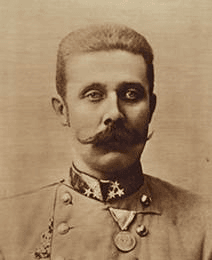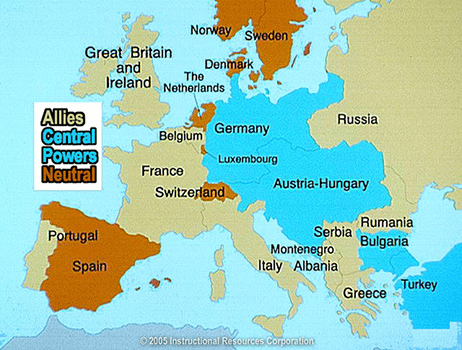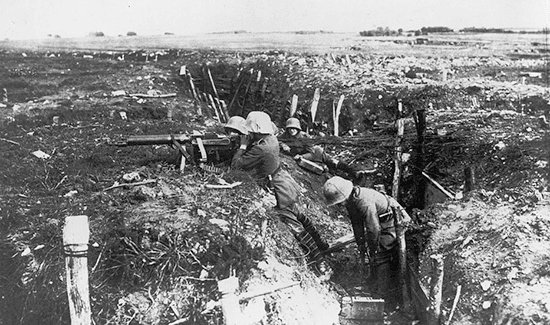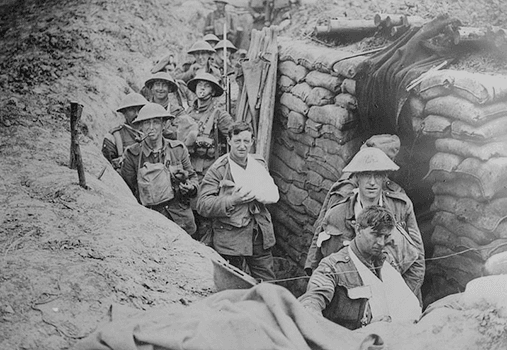Learn
MAIN Causes of World War I
The MAIN Causes of World War I
The Great War was not caused by simply one event. On the contrary, it was the result of tensions building among European nations throughout the late 1800s and 1900s.
- Militarism: building up a nation's armed forces in preparation for war. Endless planning makes war more likely.
- Alliances: complicated system of alliances developed in late 19th century
- Imperialism: the scramble for colonies sharpened rivalries
- Nationalism: acting in your own national interest while going against the interest of another nation
The MAIN Causes of World War I: Militarism
Militarism is the building up of large, technologically advanced armies.
During the late 1800s into the early 1900s, Europe experienced a rapid development of weapons, which led to an arms race between rivaling nations.
There was also a trend of generals becoming government ministers, which increased spending on defense, particularly in Germany. For example, German defense spending increased 73% between the years 1900 and 1914.
The MAIN Causes of World War I: Alliances
Alliances are created when two or more countries sign treaties and agree to ally with one another in case of war.
This is not a new concept, but following the alliance shifts in the early 1800s for or against the French leader Napoleon Bonaparte, European nations organized into two main military alliances.
The building of alliances was one of the main reasons that this war would be a "World War" involving many nations, instead of a typical war between two countries with conflicts.
The MAIN Causes of World War I: Imperialism
Imperialism is the building of an empire by acquiring colonies.
This quest for building empires causes rivalries among the powerful nations in Europe to sharpen. For example, these nations were like football in Alabama. When Alabama and Auburn are both having a great season and getting bigger and better, it causes the rivalry to sharpen. Likewise, imperialism caused these European nations to get stronger and increase competition and rivalries.
By the start of World War I, much of the world's land had been conquered. Yet in the late 1800s, the conquest to imperialize Africa intensified tensions and shifted alliances among all nations involved.
The MAIN Causes of World War I: Nationalism
Nationalism is extreme patriotism or intense pride in one's homeland. It caused nations throughout Europe to believe that their country could win any war in a short amount of time.
This sense of nationalism was a defining reason for the fierce competition between European nations. Out of nationalism rose the idea of self-determination, the idea that people who belonged to a nation should have their own country and government.
Additionally, examples in literature and art during the time displayed extreme stereotypes of other nations and cultures, which further emphasized the superiority of one's own.
Building Empires and Alliances
The death and destruction caused by fighting with new technologically advanced weapons would result in a war far greater and more disastrous than anyone could ever imagine.
World War I would become known as the "war to end all wars" and the "Great War" due to the magnitude of destruction.
The Conflict Begins

Though there were several underlying or MAIN causes of World War I, there was one particular event that triggered or started the actual declarations of war: the assassination of Archduke Franz Ferdinand in Sarajevo, Bosnia on June 28, 1914. The Archduke was the heir to the Austrian-Hungarian throne.
The archduke and his wife were killed by a Serbian nationalist (someone who advocates for political independence) named Gavrilo Princip, who was a member of a group called the "Black Hand."
This incident triggered a series of events in the summer of 1914, which ultimately led the world to war.
Timeline: Chain Reaction 1914
The assassination of Archduke Franz Ferdinand set into motion a chain of events that pulled nation after nation in Europe into war. Like dominoes, one European country after another fell into war.
- July 28: Austria-Hungary declares war on Serbia.
- July 29: Russia (Serbia's protector) prepares troops.
- August 1: Germany (Austria-Hungary's ally) declares war on Russia.
- August 3: Germany enters France (Russia's ally) under the Schlieffen Plan -- Germany's "strike first" plan to travel through Belgium to get to France (Russia's ally), which brought Great Britain, (Belgium's protector), into the war.
- August 4: Great Britain (Belgium's protector) entered the war.
The Powers

Central Powers: Germany, Austria-Hungary, (Ottoman Empire)
Allied Powers: Russia, France, Serbia, Great Britain, (Italy and United States later)
Stalemate
Both the Central and Allied Powers thought the war would end quickly. After all, they had planned endlessly for war by building large militaries, entering strong alliances to back them in case of war, and building strong empires (nationalism and imperialism).
They were all wrong! Fighting entered a stalemate in which neither side gained an advantage. Both sides set up against each other in muddy, rat-infested trenches separated only by a "no man's land".

Trenches, Weapons, and Death
.png)
Eventually, soldiers would be forced to leave the trenches and cross "no man's land" to take the enemy's trenches. Facing the machine guns, barbed wire, grenades, poison gases, and heavy artillery of the enemy caused bodies to pile up.
Modern Warfare
World War I brought a series of new killing machines:
- Machine guns that could unleash 500 to 600 rounds a minute
- Hand grenades, artillery shells, and poison gases
- Submarines (introduced by Germany), tanks (introduced by Great Britain), and planes

Trench Warfare

Fighting in the muddy and rat-infested trenches on each side of "no man's land" would often cause soldiers to develop trench foot, a common condition caused by exposure to water while standing in the muddy trenches.

Look through 10 Photos of Life in the Trenches.